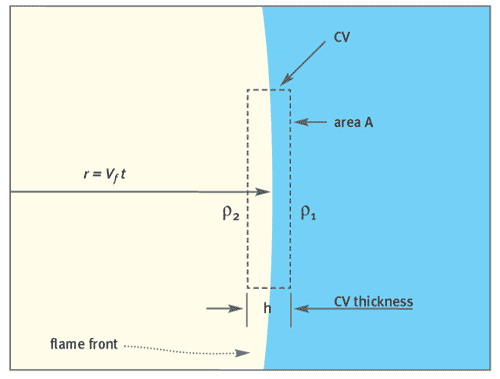2.25 Problem Sets - Section 5
Problem 5.19: Spark ignited spherical combustion
Previous Problem | Next Problem

A combustible mixture of air and fuel is initially at rest at a density r1 and uniform pressure p∞. At t = 0, the mixture is ignited at the origin by a spark and a flame front begins to move radially outward from the origin at a constant speed Vf. As the flame front overtakes a gas particle, it converts the combustible mixture of density r1 to a hotter combustion product of lower density r2. This occurs so fast that the flame front can be modeled as an infinitesimally thin density discontinuity. Because the volume of a fluid particle increases as it is enveloped by the flame front, the combustible mixture ahead of the expanding flame front is pushed radially outward by the front. The combustion products of density r2 that are left behind the flame must, however, be stationary relative to the reference frame fixed in the origin.
(a) In a reference frame fixed in the origin,
determine the radial outflow velocity v(r,t) of the combustible
mixture. There will be different expressions for the unburned gas
ahead of the flame front (r > Vft) and the
burned gas left behind (r < Vft). See also
Prob. 3.17. Show that the velocity distribution can be expressed
in the dimensionless form ![]() , where
, where
![]() is
either a dimensionless radial distance at fixed time or a dimensionless
inverse time at fixed r, and
is
either a dimensionless radial distance at fixed time or a dimensionless
inverse time at fixed r, and ![]() is
a dimensionless density difference between the unburned and burned
gases.
is
a dimensionless density difference between the unburned and burned
gases.

